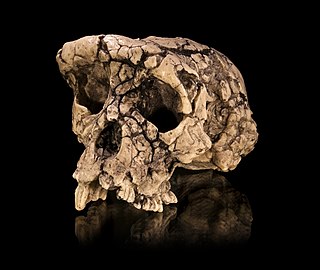
Aardvarks are medium-sized, burrowing, nocturnal mammals native to Africa. Aardvarks are the only living species of the family Orycteropodidae and the order Tubulidentata. They have a long snout, similar to that of a pig, which is used to sniff out food.

Hippopotamidae is a family of stout, naked-skinned, and semiaquatic artiodactyl mammals, possessing three-chambered stomachs and walking on four toes on each foot. While they resemble pigs physiologically, their closest living relatives are the cetaceans. They are sometimes referred to as hippopotamids.

Sahelanthropus is an extinct genus of hominid dated to about 7 million years ago during the Late Miocene. The type species, Sahelanthropus tchadensis, was first announced in 2002, based mainly on a partial cranium, nicknamed Toumaï, discovered in northern Chad.

Orycteropodidae is a family of afrotherian mammals. Although there are many fossil species, the only species surviving today is the aardvark, Orycteropus afer. Orycteropodidae is recognized as the only family within the order Tubulidentata, from the Latin words tubulis (tubule) and dentis (tooth), referring to the tubule-style teeth., so the two are effectively synonyms.

Australopithecus bahrelghazali is an extinct species of australopithecine discovered in 1995 at Koro Toro, Bahr el Gazel, Chad, existing around 3.5 million years ago in the Pliocene. It is the first and only australopithecine known from Central Africa, and demonstrates that this group was widely distributed across Africa as opposed to being restricted to East and southern Africa as previously thought. The validity of A. bahrelghazali has not been widely accepted, in favour of classifying the specimens as A. afarensis, a better known Pliocene australopithecine from East Africa, because of the anatomical similarity and the fact that A. bahrelghazali is known only from 3 partial jawbones and an isolated premolar. The specimens inhabited a lakeside grassland environment with sparse tree cover, possibly similar to the modern Okavango Delta, and similarly predominantly ate C4 savanna foods—such as grasses, sedges, storage organs, or rhizomes—and to a lesser degree also C3 forest foods—such as fruits, flowers, pods, or insects. However, the teeth seem ill-equipped to process C4 plants, so its true diet is unclear.

Anancus is an extinct genus of "tetralophodont gomphothere" native to Afro-Eurasia, that lived from the Tortonian stage of the late Miocene until its extinction during the Early Pleistocene, roughly from 8.5–2 million years ago.

Michel Brunet is a French paleontologist and a professor at the Collège de France between 2008 and 2011. In 2001 Brunet announced the discovery in Central Africa of the skull and jaw remains of a late Miocene hominid nicknamed Toumaï. These remains may predate the earliest previously known hominid remains, Lucy, by over three million years; however, this conclusion is the subject of a significant controversy.

The Afroinsectiphilia is a clade that has been proposed based on the results of recent molecular phylogenetic studies. Many of the taxa within it were once regarded as part of the order Insectivora, but Insectivora is now considered to be polyphyletic and obsolete. This proposed classification is based on molecular studies only, and there is no morphological evidence for it.
Bohlinia is an extinct genus of the artiodactyl family Giraffidae that lived during the Late Miocene in Eurasia and Africa. It was first named by the paleontologist Dr. W. Matthew in 1929, and contains two species, B. adoumi and B. attica. The species B. attica has been reclassified several times since its description being first named Camelopardalis attica and then reclassified as Giraffa attica.

Paracamelus is an extinct genus of camel in the family Camelidae. It originated in North America Around 8-7 Ma, and crossed the Beringian land bridge into Eurasia during the Late Miocene, about 6 million years ago (Ma). It is the presumed ancestor to living camels of the genus Camelus.

Lokotunjailurus is an extinct genus of saber-toothed cats (Machairodontinae) which existed during the late Miocene and earliest Pliocene epoch and is known from localities in northern, central, eastern and southern Africa. A big cat, it was more slender than comparable recent species and its build suggests cursoriality. It is grouped among a group of similar-looking saber-toothed cats known as the scimitar-tooths.
The Djurab Desert is a desert in northern Chad. Part of the greater Sahara desert, it makes up much of the area of Chad's Borkou region.

Nyanzachoerus is an extinct genus of the pig family (Suidae) belonging to the subfamily Tetraconodontinae. The several species of Nyanzachoerus lived in Africa from the Miocene to Pliocene.
Orycteropus abundulafus is an extinct species of aardvark. Its fossil was found in northern Chad. It lived in the Mio-Pliocene epochs.
Lars Werdelin is a Swedish paleontologist specializing in the evolution of mammalian carnivores. His areas of scientific interest include the evolutionary interaction of carnivores and hominins in Africa, as well as the evolution and phylogeny of carnivore clades such as the Machairodontinae, the lynxes and the Hyaenidae.
Amphiorycteropus is an extinct genus of mammals in the family Orycteropodidae within Tubulidentata. The genus is known from fossils dating from Middle Miocene to Early Pliocene, found in Africa, Asia and Europe.

Cercopithecoides is an extinct genus of colobine monkey from Africa which lived during the latest Miocene to the Pleistocene period. There are several recognized species, with the smallest close in size to some of the larger extant colobines, and males of the largest species weighed over 50 kilograms (110 lb).
Tchadailurus is a genus of machairodontine felid from the late Miocene of Chad, Africa.

Serengetilagus is an extinct genus of lagomorph in the family Leporidae. It lived in the Pliocene of Kenya and Tanzania and the Late Miocene of Chad. Serengetilagus is the best-represented taxon from Laetoli, with approximately 34 percent of fossils in the Laetolil Beds attributed to this genus. Additional specimens from Angola, Morocco and Ukraine may also belong to this genus. It had a number of specific features unknown in other lagomorphs, such as a "missing" mesoflexid on its third premolar.

Afrocygnus is an extinct genus of swan, which lived during the Late Miocene, and perhaps up to the Late Pliocene, in what is today North Africa. The only genus of swan known in Africa, aside from fragmentary Pleistocene remains found in East Africa and from occasional observations of vagrant European swans along the Mediterranean coast, it lived in what was during the Miocene a damp wetland spanning from Libya to Chad, alongside the Antracothere Libycosaurus and the early Homininae Sahelanthropus. The genus is considered as the sister taxon of the extant genus Cygnus. Fossils of the genus have been uncovered in the Sahabi Formation of Cyrenaica in Libya, and in the Toros-Menalla locality in the Djurab Desert of Northern Chad.














